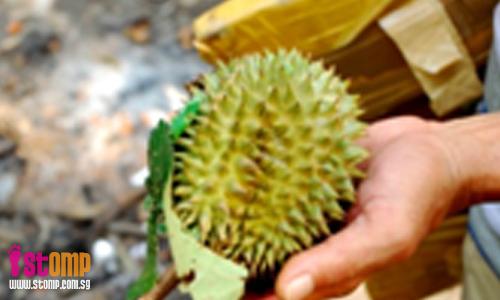
STOMPer Isaac says some durian lovers have managed to get durians for free by waiting for them to fall from durian trees in the wooded areas around Bukit Batok or Punggol.
In an email to STOMP yesterday (Jul 2), the STOMPer said:
"It is the durian season again and typically if you are a durian lover, you would have to pay for it whether it is of the D24 variety or unnamed type.
"However, some have got it for free by waiting for the durians to fall from durian trees in the wooded areas around Bukit Batok or Punggol.
"If you do not have patience for nature to do its work, an excavator to rock the trees for the fruit to fall might just to the trick.
"This was what I found out from a trip to Punggol this morning.
"I was there to take some pictures of the durian trees and the durians before it was all gone when I chanced upon some folks who were there to pick durians.
"One guy was quite upset as he related to me that some construction workers who were clearing the area in the vicinity used the excavator to knock on one of the durian trees till the fruits fell.
"I talked to the foreman who was present at the area and in the small chat that followed, he said that he was tasked to clear the area where the durian trees because a huge water pipe would be laid across.
"I took the opportunity to mention to him that his workers had actually vandalised the trees and that this kind of activity was not acceptable. He was apologetic and assured me that he will take care of the problem.
"For readers who are interested in picking these durians free of charge, you will have to compete with other folks who actually camp overnight to wait for the sweet sound of the durians to fall through, typically in the wee hours of the morning."
Other durian stories:
Durian Loop better than Botanic Gardens
Durian trees grow in Lim Chu Kang cemetery
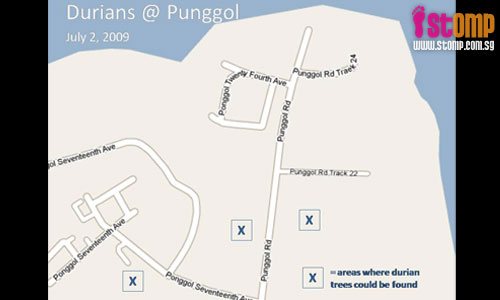

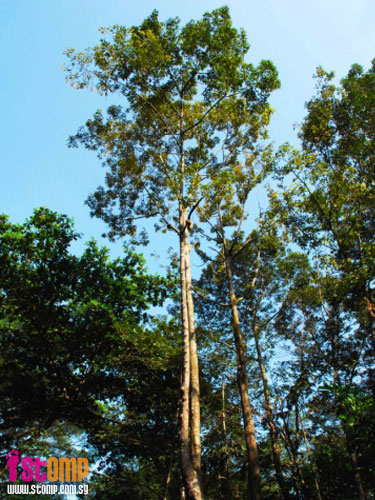
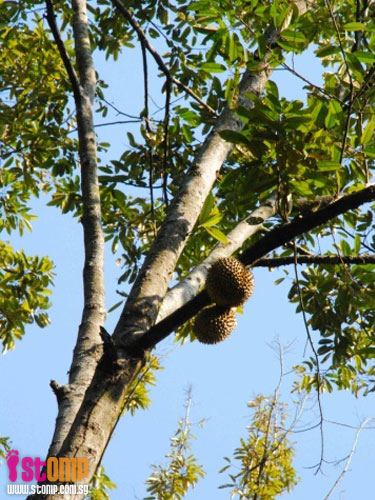
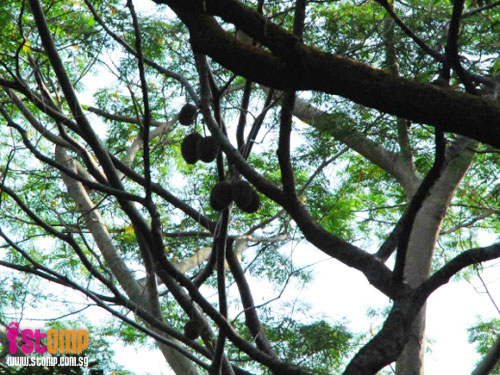
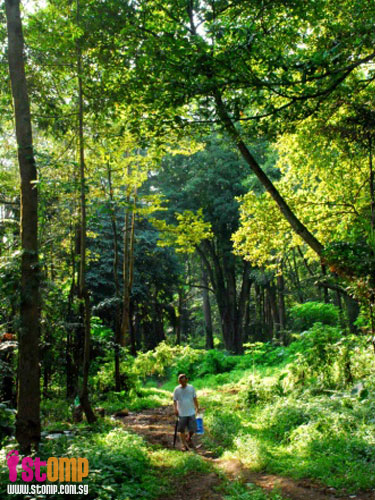
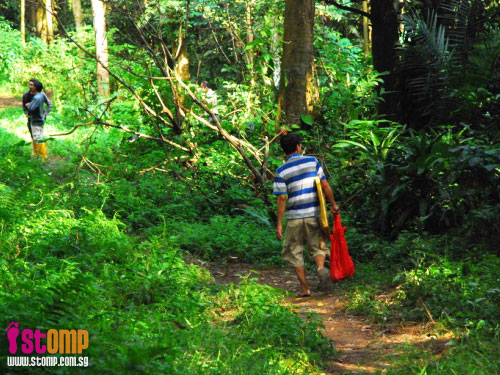
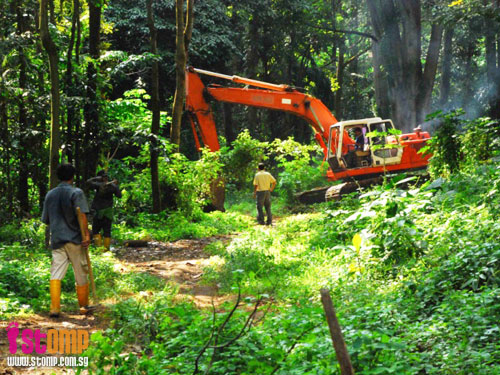
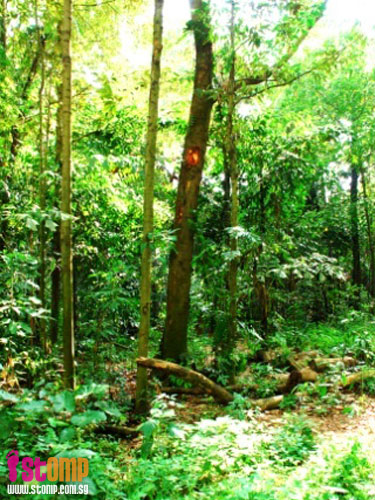
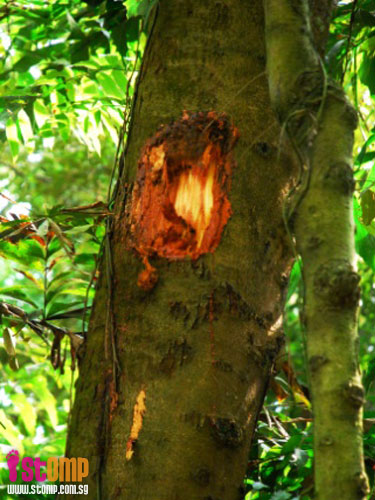


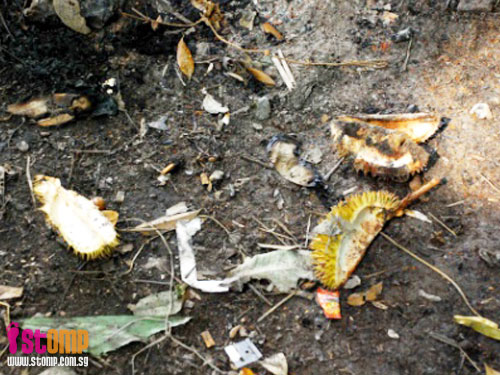

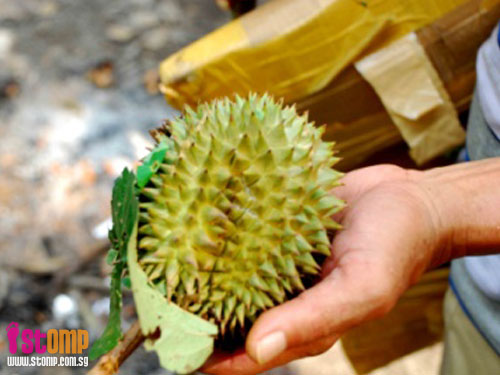
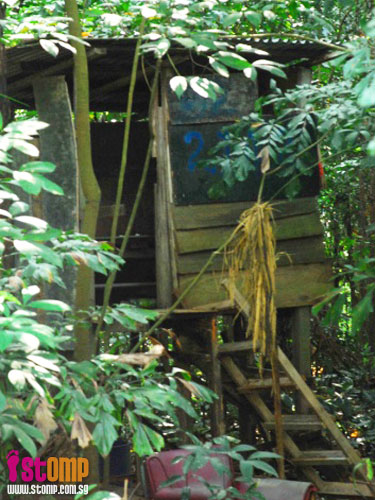
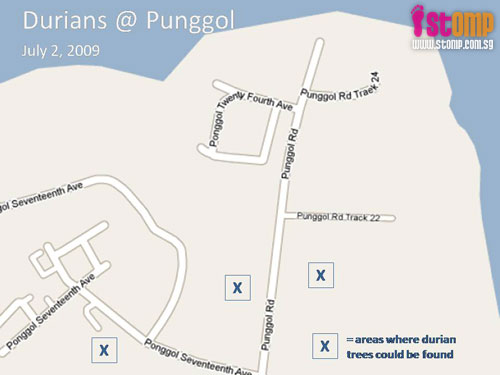
Related articles: All for the love of Durian (29th June 2009) (Mirror)
Durian warning and happy pickings at park (2nd May 2009) (Mirror)
Free durians for the picking (20th July 2008) (Mirror)
Related posts: Blue net at Pulau Ubin can save your life (4th June 2009)
Durian trees grow in Lim Chu Kang cemetery (8th April 2009)
I normally publish these posts from STOMP with minimal editing, but today, I was facing a bit of a dilemma, and was wondering if I ought to censor the contents of this post a little.
As you can see, when this person submitted this post to STOMP, he also included a map that pinpointed the locations of durian trees in this part of Punggol. I wonder if the people who frequent the area during this time of the year will be pleased at all.
I realise that it might not be much of a secret, and that revealing the location by marking it down on a map and posting it on STOMP may just be stating the obvious, but still, I'm not comfortable in broadcasting the location so that anybody can just head down and jostle for space with all the other folks who are there for their share of durian.
I'm not one of those who heads down to the forests for durian fresh from the trees, but I would expect the people to be not too pleased at having to compete for prime territory with a whole bunch of other people who have come down out of curiosity or just plain greed.
Not to mention the possible impact from an even larger number of people walking around, trampling vegetation, frightening away wildlife and in some cases, leaving behind rubbish.
Here, in the case of the durians at Punggol, the same location had already more or less been divulged by The New Paper, which included a map of the area in their recent article. The person who submitted the map to STOMP might not have made any significant difference, since many other people would already be aware of the site. If I had chosen not to repost the maps on my blog, it might not have made much impact at all, since anyone could follow the link to the original article on STOMP and view the map for themselves.
As nature lovers, we often face a great dilemma. It is essential to raise awareness of our nature areas and of wildlife sightings, so that people know that we have these places of great beauty and value. Yet at the same time, there is always the risk that with greater awareness and greater accessibility, more people will visit and inadvertently lead to the degradation and destruction of what they've come to appreciate. It's my greatest fear that someday, Chek Jawa might face this fate; after reclamation was deferred, so many people visited, unthinkingly trampling and collecting marine life that the place was in danger of being loved to death. Now, with the boardwalk and trails, more people are given the chance to explore and appreciate the place, yet there is also the chance that litter is given the chance to accumulate, due to the extremely irresponsible actions of certain visitors.
In this older post on STOMP, you can view a very interesting discussion in the comments about the struggle between keeping locations a secret to protect them from thoughtless actions by the general public, and raising awareness of these sites to increase public support for their protection.
Similarly, where birdwatching is concerned, revealing the location of a rare bird often means that hordes of enthusiasts will descend upon the location, and there is always the risk that some of these will be irresponsible enough to deliberately trample the vegetation and disturb the wildlife. In the case of nesting birds, revealing the location invites poachers and unwanted trespassers who might cause so much distress that the breeding attempt fails. You can see an example of how agitated people can get when a nest site is revealed online over at this post on the Bird Ecology Study Group.
Yet on the other hand, by being overly secretive and wary of sharing information, we deprive others of sharing in the joy of our discoveries. Ordinary people who might take a benign interest stand to learn a lot from experts willing to tolerate their presence, and they in turn may pass on their knowledge to the people around them. If we zealously guard the secret of every rare bird sighting, nesting record, or exploration of a new shore, nature appreciation transforms into a highly elitist activity, open only to a small group with the right connections. This is definitely not the right sort of environment for a novice to learn from others who are more experienced, especially if these amateurs are deliberately being kept out of the information loop. How then are these beginners supposed to grow and develop their knowledge and skills, and eventually take over from the old-timers?
Besides, there will always be times when we need the public to be aware of what we still have out there, and what we stand to lose if we don't do anything to protect these threatened places and species. The campaign to raise awareness and garner public support was probably one of the main driving factors behind the government's decision to defer reclamation of Chek Jawa. If the place had remained a closely-guarded secret, known only to a select few, I doubt that the move to save it from development would have managed to make much headway at all. Similarly, by publicising reports of sightings of rare and endangered species, we alert others to the fact that these species are still surviving here in Singapore. Yes, raising awareness can inadvertently attract the wrong kind of attention, but it is a risk that we all must take.
Ultimately, a balance has to be struck between keeping certain things a secret, and publicising the information. There will be times when it is necessary not to reveal the location of a particular sighting, so as to protect the animals or habitat from excessive attention. Yet at the same time, there will be times when it is in everyone's best interests to widely disseminate information, so as to raise awareness for the need to protect certain threatened habitats. The whole reason why there are some many nature-themed blogs in Singapore is that we are well aware of the need to fight the perception that there is very little biodiversity left in Singapore, and there is little worth saving. By blogging about our trips and encounters, we hope to have an easily accessible online resource that enables anyone to see that Singapore still possesses a great deal of biodiversity and natural heritage, and encourage people to be more sensitive and aware of how irresponsible actions can negatively impact the environment and the myriad species which still survive in our midst.